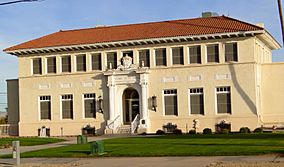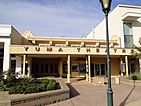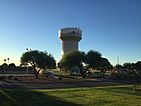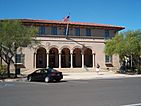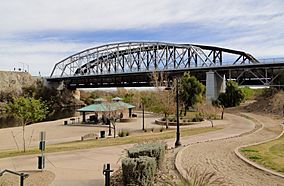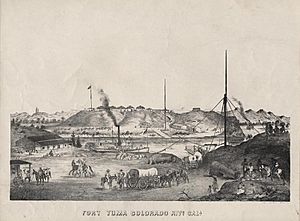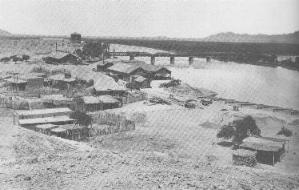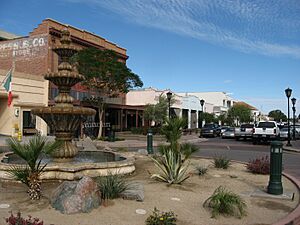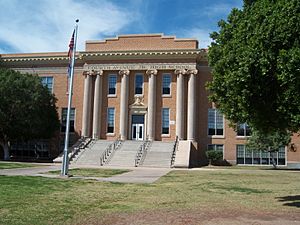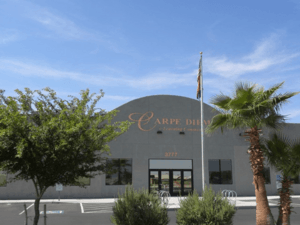Yuma, Arizona facts for kids
Quick facts for kids
Yuma, Arizona
|
|||
|---|---|---|---|
|
Clockwise from top: Old Yuma City Hall, Yuma Theatre, Old Yuma Post Office, Ocean to Ocean Bridge, Yuma water tower, Yuma County Courthouse
|
|||
|
|||

Location of Yuma in Yuma County, Arizona
|
|||
| Country | United States | ||
| State | Arizona | ||
| County | Yuma | ||
| Incorporated | 1914 | ||
| Government | |||
| • Type | Council-Manager | ||
| • Body | Yuma City Council | ||
| Area | |||
| • City | 120.84 sq mi (312.97 km2) | ||
| • Land | 120.77 sq mi (312.79 km2) | ||
| • Water | 0.07 sq mi (0.18 km2) 0.07% | ||
| Elevation | 256 ft (78 m) | ||
| Population
(2020)
|
|||
| • City | 95,548 | ||
| • Density | 791.18/sq mi (305.47/km2) | ||
| • Urban | 135,717 (US: 253rd) | ||
| • Metro | 203,247 (US: 214th) | ||
| Demonym(s) | Yuman | ||
| Time zone | UTC−7 (MST) | ||
| ZIP codes |
85364–85367, 85369, 85350
|
||
| Area code(s) | 928 | ||
| FIPS code | 04-85540 | ||
| GNIS ID | 2412328 | ||
| Major airport | Yuma International Airport | ||
| Website | www.yumaaz.gov | ||
Yuma is a city in and the county seat of Yuma County, Arizona, United States. The city's population was 95,548 at the 2020 census, up from the 2010 census population of 93,064.
Yuma is the principal city of the Yuma, Arizona, Metropolitan Statistical Area, which consists of Yuma County. According to the United States Census Bureau, the 2020 estimated population of the Yuma MSA is 203,247. According to Guinness World Records, Yuma is the "Sunniest City on Earth," promising "sunshine and warm weather at least 91% of the year." Anywhere from 70,000 to over 85,000 out-of-state visitors make Yuma their winter residence.
Yuma's weather also makes it an agricultural powerhouse, growing over 175 types of crops, the largest of which is lettuce. Yuma County provides 90% of all leafy vegetables grown from November to March in the United States. Yuma is also known for its large military population due to several military bases, including the Marine Corps Air Station.
Yuma is in the state's southwestern corner, in the Sonoran Desert, Yuma Desert sub-region.
Contents
History
The area's first settlers for thousands of years were Native American cultures and historic tribes. Their descendants now occupy the Cocopah and Quechan reservations.
In 1540, Spanish colonial expeditions under Hernando de Alarcón and Melchior Díaz visited the area and immediately recognized the natural crossing of the Colorado River as an ideal spot for a city. The Colorado River narrows to slightly under 1,000 feet (300 m) wide in one area. Military expeditions that crossed the Colorado River at the Yuma Crossing include Juan Bautista de Anza (1774), the Mormon Battalion (1848) and the California Column (1862).
During and after the California Gold Rush to the late 1870s, the Yuma Crossing was known for its ferry crossings for the Southern Emigrant Trail. This was considered the gateway to California, as it was one of the few natural spots where travelers could cross the otherwise very wide Colorado River.
First settlements
Following the United States establishing Fort Yuma, two towns developed one mile downriver. The one on the California side was called Jaeger City, named after the owner of Jaeger's Ferry, which crossed the river there. It was for a time the larger of the two, with the Butterfield Overland Mail office and station, two blacksmiths, a hotel, two stores, and other dwellings.
The other was called Colorado City. Developed on the south side of the river in what is now Arizona by speculator Charles Poston, it was the site of the custom house. When started, it was just north of the border between Mexican-ruled Sonora, Mexico and California. After the Gadsden Purchase by the United States, the town bordered on the Territory of New Mexico. This area was designated as the Territory of Arizona in 1863. The Colorado City site at the time was duly registered in San Diego; both banks of the Colorado River just below its confluence with the Gila were recognized as being within the jurisdiction of California. The county of San Diego collected taxes from there for many years.
From 1853 a smaller settlement, Arizona City, grew up on the high ground across from the fort and was organized under the name of its post office in 1858. It had adobe dwellings, two stores and two saloons. Colorado City and Jaeger City were almost completely destroyed by the Great Flood of 1862 and had to be rebuilt on higher ground. At that time Colorado City became part of Arizona City, later on taking the name Yuma in 1873.
Early development
From 1854, Colorado City was the major steamboat stop for traffic up and down the Colorado River. After the 1862 flood, it became part of Arizona City. The steamboats transported passengers and equipment for the various mines and military outposts along the Colorado; Colorado City was the terminus of wagon traffic up the Gila River into New Mexico Territory. They offloaded the cargo from ships at the mouth of the Colorado River at Robinson's Landing and from 1864 at Port Isabel. From 1864, the Yuma Quartermaster Depot, today a state historic park, supplied all forts in present-day Arizona, as well as large parts of Colorado and New Mexico. After Arizona became a separate territory, Yuma became the county seat for Yuma County in 1871, replacing La Paz, the first seat.
The Southern Pacific Railroad bridged the river in 1877, and acquired George Alonzo Johnson's Colorado Steam Navigation Company, the only steamboat company on the river. Yuma became the new base of navigation on the river, ending the need for Port Isabel, which was abandoned in 1879. The warehouses and shipyard there were moved to Yuma.
Geography
Yuma is near the borders of California to the west and Mexico to the south, and just west of the Gila River's confluence with the Colorado. The city is approximately 60 miles (100 km) from the Gulf of California (Sea of Cortez), a branch of the Pacific.
According to the United States Census Bureau, the city has a total area of 106.7 square miles (276 km2), of which 106.6 square miles (276 km2) is land and 0.1 square miles (0.26 km2) (0.07%) is water.
Climate
Yuma is noted for its weather extremes. Of any populated place in the contiguous United States, Yuma is the driest, the sunniest, and the least humid, has the lowest frequency of precipitation, and has the highest number of sunny days per year—175—with a daily maximum temperature of 90 °F (32 °C) or higher.
Yuma features a hot desert climate (Köppen climate classification BWh), with extremely hot summers and warm winters. Atmospheric humidity is usually very low, except during what are called "Gulf surges", when a maritime tropical air mass from the Gulf of California is drawn northward, usually in connection with the summer monsoon or the passage of a tropical storm to the south.
The sun is said to shine during about 90% of the daylight hours, making Yuma one of the sunniest places in the world. The city receives the most recorded mean sunshine of anywhere on Earth, although the equipment used by the United States tends to provide higher sunshine estimates than the traditional Campbell–Stokes recorder.
On average, Yuma receives 3.36 inches (85 mm) of rain annually. Even in the wettest year of 2005, only 7.39 in (188 mm) fell. The driest year at Yuma Airport was 2007, with only 0.15 in (3.8 mm) recorded. On average, the wettest months of the year are during the monsoon months of August and September, and December, when moisture from winter storms arrives from the Pacific Ocean. June is the driest month, with drought virtually absolute.
In 1995, Yuma recorded its all-time high temperature of 124 °F (51 °C). The lowest recorded temperature was in the Yuma-Mesa area in January 2007. The temperature fell to 21 °F (−6 °C) for approximately two hours, harming many crops grown in and around Yuma. Citrus suffered the most, particularly the lemon crop. According to an Arizona Department of Agriculture report in February 2007, there was a 75% to 95% loss of crop and trees. On average (according to the 1991-2020 climate period), the temperature reaches freezing point in one year in fifteen, and there are 117 days per year during which the temperature reaches or exceeds 100 °F (38 °C), usually from April through October. During July and August, the temperature fails to reach 100 °F (38 °C) on only one and two days on average, respectively.
In 1997, the desert city sustained a full tropical storm after Hurricane Nora made landfall at the mouth of the Colorado River and quickly moved due north along it. This rare event cut power to 12,000 customers in Yuma, and dropped 3.59 inches (91 mm) of rain at Marine Corps Air Station Yuma. The last time a hurricane had hit near Yuma was in mid-August 1977, when similar rainfalls were recorded.
| Climate data for Yuma, Arizona (Yuma Int'l), 1981–2010 normals, extremes 1878–present | |||||||||||||
|---|---|---|---|---|---|---|---|---|---|---|---|---|---|
| Month | Jan | Feb | Mar | Apr | May | Jun | Jul | Aug | Sep | Oct | Nov | Dec | Year |
| Record high °F (°C) | 88 (31) |
97 (36) |
102 (39) |
107 (42) |
120 (49) |
122 (50) |
124 (51) |
120 (49) |
123 (51) |
112 (44) |
98 (37) |
91 (33) |
124 (51) |
| Mean maximum °F (°C) | 79.4 (26.3) |
85.0 (29.4) |
92.9 (33.8) |
100.0 (37.8) |
106.8 (41.6) |
112.6 (44.8) |
114.7 (45.9) |
114.3 (45.7) |
110.8 (43.8) |
102.1 (38.9) |
89.1 (31.7) |
77.8 (25.4) |
116.2 (46.8) |
| Mean daily maximum °F (°C) | 69.6 (20.9) |
73.8 (23.2) |
79.9 (26.6) |
86.4 (30.2) |
95.3 (35.2) |
103.5 (39.7) |
106.8 (41.6) |
106.2 (41.2) |
101.3 (38.5) |
89.9 (32.2) |
77.5 (25.3) |
68.3 (20.2) |
88.2 (31.2) |
| Mean daily minimum °F (°C) | 47.6 (8.7) |
50.1 (10.1) |
54.4 (12.4) |
59.6 (15.3) |
67.3 (19.6) |
74.6 (23.7) |
82.1 (27.8) |
82.3 (27.9) |
76.5 (24.7) |
65.0 (18.3) |
53.9 (12.2) |
46.6 (8.1) |
63.3 (17.4) |
| Mean minimum °F (°C) | 37.3 (2.9) |
39.7 (4.3) |
43.9 (6.6) |
49.1 (9.5) |
56.4 (13.6) |
64.3 (17.9) |
74.1 (23.4) |
73.6 (23.1) |
65.3 (18.5) |
54.2 (12.3) |
43.1 (6.2) |
36.4 (2.4) |
34.6 (1.4) |
| Record low °F (°C) | 22 (−6) |
25 (−4) |
31 (−1) |
38 (3) |
39 (4) |
50 (10) |
61 (16) |
58 (14) |
50 (10) |
35 (2) |
29 (−2) |
22 (−6) |
22 (−6) |
| Average precipitation inches (mm) | 0.36 (9.1) |
0.33 (8.4) |
0.34 (8.6) |
0.12 (3.0) |
0.03 (0.76) |
0.01 (0.25) |
0.26 (6.6) |
0.52 (13) |
0.53 (13) |
0.21 (5.3) |
0.20 (5.1) |
0.45 (11) |
3.36 (85) |
| Average precipitation days (≥ 0.01 in) | 2.3 | 2.0 | 1.8 | .8 | .4 | .2 | .9 | 2.3 | 1.2 | 1.1 | 1.0 | 2.1 | 16.2 |
| Mean monthly sunshine hours | 268.4 | 270.8 | 335.5 | 365.5 | 407.4 | 415.4 | 392.6 | 375.6 | 341.7 | 319.6 | 270.1 | 252.7 | 4,015.3 |
| Percent possible sunshine | 84 | 88 | 90 | 94 | 95 | 97 | 90 | 91 | 92 | 91 | 86 | 81 | 90 |
| Source: NOAA | |||||||||||||
Snow in Yuma has only been recorded on December 12, 1932, when a light coating of snow covered the city for the first and only time in its history. A few flakes fell in January 1937 and December 1967, mixed with rain.
Demographics
| Historical population | |||
|---|---|---|---|
| Census | Pop. | %± | |
| 1860 | 130 | — | |
| 1870 | 1,144 | 780.0% | |
| 1880 | 1,200 | 4.9% | |
| 1890 | 1,773 | 47.8% | |
| 1900 | 1,519 | −14.3% | |
| 1910 | 2,914 | 91.8% | |
| 1920 | 4,237 | 45.4% | |
| 1930 | 4,892 | 15.5% | |
| 1940 | 5,325 | 8.9% | |
| 1950 | 9,145 | 71.7% | |
| 1960 | 23,974 | 162.2% | |
| 1970 | 29,007 | 21.0% | |
| 1980 | 42,481 | 46.5% | |
| 1990 | 54,923 | 29.3% | |
| 2000 | 77,515 | 41.1% | |
| 2010 | 93,064 | 20.1% | |
| 2020 | 95,548 | 2.7% | |
| U.S. Decennial Census | |||
Yuma first appeared on the 1860 U.S. Census as the village of "Arizonia" (Arizona City) in what was then Arizona County, New Mexico Territory (see Arizona City (Yuma, Arizona) for details). It returned as Arizona City in 1870 and then became Yuma in 1873. On April 12, 1902, the village of Yuma was incorporated as a town. It formally incorporated as a city on April 7, 1914.
2022 American Community Survey
As of 2022[update] American Community Survey estimates, there were 98,517 people and 39,210 households. The population density was 813.9 inhabitants per square mile (314.2/km2). There were 45,408 housing units at an average density of 375.2 per square mile (144.9/km2). The racial makeup of the city was 39.7% White, 27.9% some other race, 2.4% Black or African American, 1.5% Asian, and 0.8% Native American or Alaskan Native, with 27.7% from two or more races. Hispanics or Latinos of any race were 66.5% of the population.
Of the 39,210 households, 37.8% had children under the age of 18 living with them, 32.2% had seniors 65 years or older living with them, 48.2% were married couples living together, 6.8% were couples cohabitating, 17.4% had a male householder with no partner present, and 27.6% had a female householder with no partner present. The median household size was 2.45 and the median family size was 2.96.
The age distribution was 26.3% under 18, 12.9% from 18 to 24, 26.5% from 25 to 44, 16.7% from 45 to 64, and 17.7% who were 65 or older. The median age was 33.6 years.
The median income for a household was $58,043, with family households having a median income of $65,926 and non-family households $32,347. The per capita income was $31,467. Out of the 96,149 people with a determined poverty status, 9.8% were below the poverty line. Further, 10.5% of minors and 11.6% of seniors were below the poverty line.
In the survey, residents self-identified with various ethnic ancestries. People of English descent made up 5.6% of the population of the town, followed by German at 5.0%, American at 3.4%, Irish at 3.1%, Sub-Saharan African at 1.4%, Swedish at 1.4%, Italian at 1.3%, French at 0.9%, Norwegian at 0.7%, Scottish at 0.6%, and Scotch-Irish at 0.5%.
2020 census
| Race / Ethnicity (NH = Non-Hispanic) | Pop 2000 | Pop 2010 | Pop 2020 | % 2000 | % 2010 | % 2020 |
|---|---|---|---|---|---|---|
| White (NH) | 36,784 | 35,306 | 29,815 | 47.45% | 37.94% | 31.20% |
| Black or African American (NH) | 2,220 | 2,532 | 2,069 | 2.86% | 2.72% | 2.17% |
| Native American or Alaska Native (NH) | 747 | 992 | 843 | 0.96% | 1.07% | 0.88% |
| Asian (NH) | 1,086 | 1,561 | 1,786 | 1.40% | 1.68% | 1.87% |
| Pacific Islander or Native Hawaiian (NH) | 105 | 143 | 135 | 0.14% | 0.15% | 0.14% |
| Some other race (NH) | 100 | 136 | 362 | 0.13% | 0.15% | 0.38% |
| Mixed race or Multiracial (NH) | 1,073 | 1,361 | 2,318 | 1.38% | 1.46% | 2.43% |
| Hispanic or Latino (any race) | 35,400 | 51,033 | 58,220 | 45.67% | 54.84% | 60.93% |
| Total | 77,515 | 93,064 | 95,548 | 100.00% | 100.00% | 100.00% |
2010 census
As of the 2010 census, there were 93,064 people. There were 38,626 housing units in Yuma city, 79.5% of which were occupied housing units. The racial makeup of the city was 37.9% White, 2.7% Black or African American, 1.1% Native American, 1.7% Asian, 0.2% Pacific Islander, and 1.6% from two or more races. 54.8% of the population were Hispanic or Latino of any race.
Economy
The Yuma Metropolitan Statistical Area has the highest unemployment rate in the United States as of 2018 at 20.9%. A large percentage of the work force is employed seasonally in agriculture, contributing to apparent unemployment.
Yuma is colloquially referred to as the "Winter Lettuce Capital of the World".
Top employers
According to the city's 2019 Comprehensive Annual Financial Report, the top employers in the Yuma Metropolitan Statistical Area in 2018 were:
| # | Employer | # of employees |
|---|---|---|
| 1 | Marine Corps Air Station Yuma | 5,568 |
| 2 | Yuma Union High School District | 3,100 |
| 3 | U.S. Army Yuma Proving Ground | 2,382 |
| 4 | Yuma Regional Medical Center | 2,300 |
| 5 | Yuma County | 1,437 |
| 6 | Yuma Elementary School District | 1,400 |
| 7 | City of Yuma | 1,274 |
| 8 | TRAX | 1,125 |
| 9 | United States Border Patrol | 1,000 |
| 10 | Arizona Western College | 987 |
Other large employers include Bose, Dole Fresh Vegetables and Shaw Industries.
Arts and culture
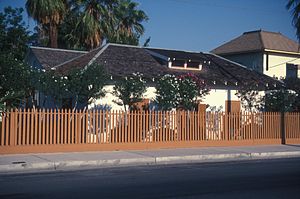
Yuma contains the historical Yuma Territorial Prison, the Yuma Quartermaster Depot State Historic Park (formerly known as the Yuma Crossing Historic Park), and a historic downtown area. Yuma is an Arizona Main Street City. Because of budget cutbacks at the state level, Arizona State Parks no longer operates the Territorial Prison and Quartermaster Depot. They are now operated by the Yuma Crossing National Heritage Area and the City of Yuma. The Yuma Visitors' Bureau oversees the Welcome Center at the Quartermaster Depot and is the official visitors' center for the Yuma Community.
Near Yuma are the Kofa Mountain Range and wildlife refuge, Martinez and Mittry Lakes, and the Algodones Dunes.
The city is the location of the Marine Corps Air Station Yuma, which conducts an annual air show and many large-scale military exercises. There is also the Yuma Proving Ground, an Army base that tests new military equipment. Yuma Proving Ground is also home to the Special Operations Free Fall School, which provides training in free-fall parachute operations to Special Forces units in all branches of service, as well as those of other nations.
The Colorado River runs along the north and west side of town, serving as the border between Arizona and California. Yuma is an important station for trucking industry movement of goods between California, Arizona and Mexico.
The Rialto movie theater once owned a Kilgen pipe organ, one of the most expensive pipe organs to have been made. Originally played as accompaniment to silent films, it has been moved to the Yuma Theatre.
Every February residents and visitors enjoy the annual rodeo, the Yuma Jaycees Silver Spur Rodeo. A parade opens the events. Cowboys and cowgirls from all over the country compete in the festivities.
The Yuma County Fair takes place annually in the spring at the fairgrounds in Yuma.
On New Year's Eve 2018, the town of Yuma dropped a head of iceberg lettuce from the town's water tower, to symbolize the beginning of the new year, much like the ball drop in New York City's Times Square. This is known as the "Iceberg Drop".
Sports
Yuma has a soccer-specific stadium, Desert Sun Stadium, which hosted Frontera United of the United Premier Soccer League from 2015 to 2017. Previously a baseball facility, Desert Sun Stadium was home to the Yuma Desert Rats of the North American League and site of home games of four teams for the Arizona Winter League. The San Diego Padres used the field as a spring training facility from 1969 until 1993 and a Japanese baseball team, the Yakult Swallows, used the field for spring training from 1995 to 2015. Many local club sports exist in the area as well, including the Yuma Sidewinders Rugby Football Club. The rugby team participates in the Division III Arizona Men's Rugby league, and travels throughout Arizona, California and Nevada, as well as playing home games in Yuma.
Education
The city is zoned to the Yuma Union High School District. Yuma has five public high schools: Yuma Union High School, Kofa High School, Cibola High School, Gila Ridge High School, Vista Alternative High School; and the private Yuma Catholic High School and Calvary Baptist School. Yuma also has three charter high schools: Desert View Middle & High School, Harvest Preparatory Academy, and YPIC Charter High School.
Yuma has two main elementary school districts, District One and Crane District, which include several schools as well as junior high schools. Yuma has four charter elementary school: AmeriSchools Academy North and South, Harvest Preparatory Academy, and Desert View Academy.
Additionally, Yuma has six private elementary schools: Yuma Lutheran School, Yuma Adventist Christian School, Immaculate Conception School, St. Francis of Assisi School, Calvary Baptist School and Southwestern Christian School.
Arizona Western College is Yuma's community college, serving primarily as a choice for transfer students and those with shorter career goals.
All three public state universities offer undergraduate and graduate degree programs at the AWC Yuma campus. Northern Arizona University has a branch campus, Arizona State University operates an ASU Local site, and the University of Arizona has a facility adjacent to the campus.
Yuma is served by the Yuma County Library District which consists of a Main Library and several branches, including sites in Somerton, Wellton, Fortuna Foothills, and San Luis. A new main state-of-the-art library is now open.
Media
- Yuma Sun newspaper
- KECY-TV FOX, ABC, CW and Telemundo Affiliate
- KYMA-DT NBC and CBS Affiliate
- KCFY 88.1 KCFY Christian Radio
- KAWC-FM 88.9 FM Public Radio (Arizona Western College)
- KYRM 91.9 FM Radio Manantial
- KLJZ 93.1 FM Adult Contemporary Radio
- KTTI 95.1 FM Country Radio
- XHMIX 98.3 FM Top 40 Radio
- KQSR 100.9 FM Adult Contemporary Radio
- KCEC 104.5 FM Regional Mexican Radio
- KBLU 560 AM Talk Radio
- KOFA 1320 AM Public Radio (Arizona Western College)
- KCYK 1400 AM Country Radio
Infrastructure
Transportation
- Yuma County Area Transit
- Yuma International Airport
- Yuma Station (Amtrak)
- Greyhound Lines, which utilizes a stop at 1245 South Castle Dome Avenue.
- FlixBus, which utilizes a stop at 2931 East Gila Ridge Road.
- Camel Express to Quartzsite, Arizona
- Interstate 8
- Business Loop 8
- U.S. Route 95
- Arizona State Route 195
Notable people
- Alex Barrett (born 1994), American football player
- Ryan Bedford, Olympic speed skater
- Darrell Bevell, quarterbacks coach for the Miami Dolphins
- Charles Brinley, actor of the silent era
- Cesar Chavez, Mexican American civil rights leader
- Tom Childs, miner and rancher
- Curley Culp, NFL player for Kansas City Chiefs, member of Pro Football Hall of Fame
- Jason DeCorse, guitarist for The Icarus Line
- Efrain Escudero, NCAA All-American wrestler and mixed martial artist
- Eduardo Franco (born 1994), actor
- Edgar Garcia, mixed martial artist, and UFC
- Irving Garcia, USL Pro player for Los Angeles Blues
- Kelvin Gastelum, Ultimate Fighter 17 reality TV show champion
- Bill Hudson, Alaska state legislator
- Ron Jessie, NFL wide receiver for Los Angeles Rams
- Robert Wilson Kennerly, retired politician and community leader
- Curtis Lee, singer
- Jonathan Lines, businessman, former Chair of Arizona Republican Party
- Jose Maria Redondo, entrepreneur and former mayor of Yuma
- Mike Marshall, manager of Yuma Scorpions, won two World Series rings with Los Angeles Dodgers
- Bengie Molina, Major League Baseball catcher for the Texas Rangers
- Bobby Pacho, 1930s professional boxer and Welterweight world title contender
- Bob Porter, major league baseball player
- DeForest Porter, mayor of Phoenix; Justice, Arizona Territory Supreme Court
- John Shanssey, boxer, gambler, saloon owner, and Mayor of Yuma
- Cain Velasquez, UFC heavyweight champion, All-American collegiate wrestler
- Roger L. Worsley, educator; lived in Yuma, 1959 to 1963
See also
 In Spanish: Yuma para niños
In Spanish: Yuma para niños


